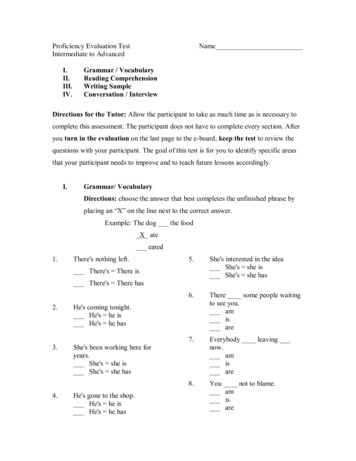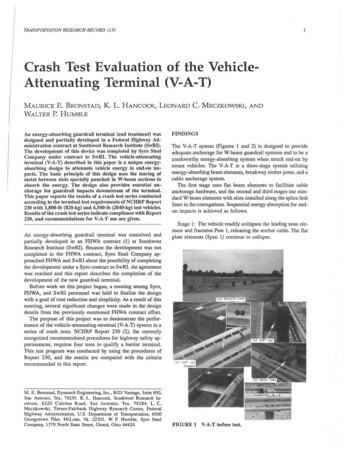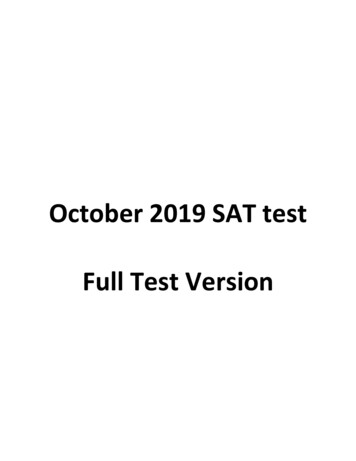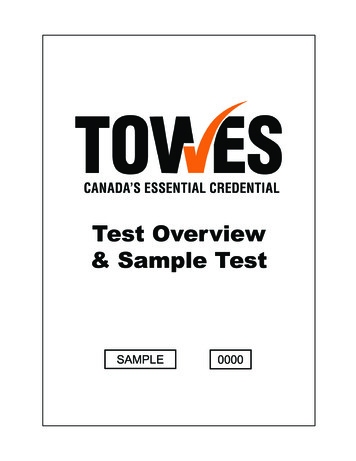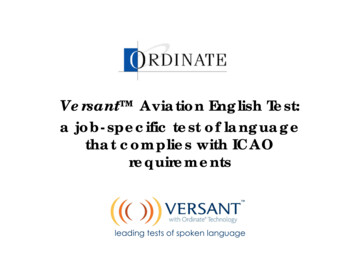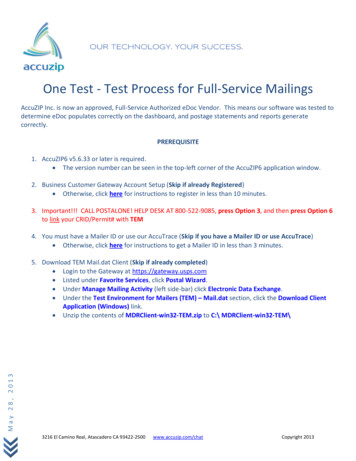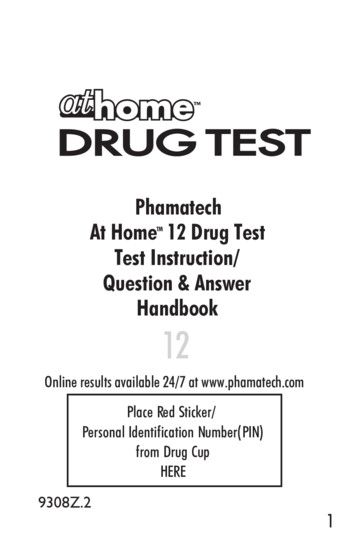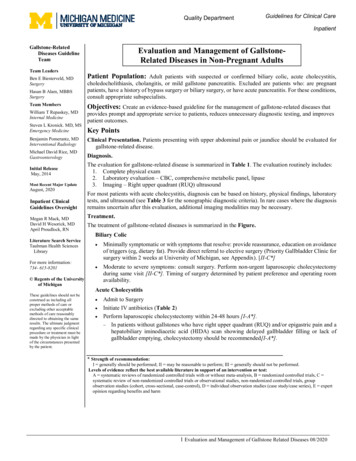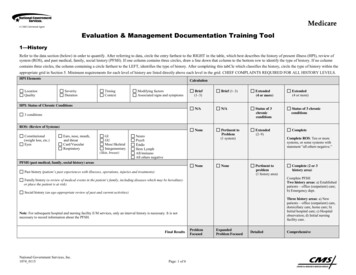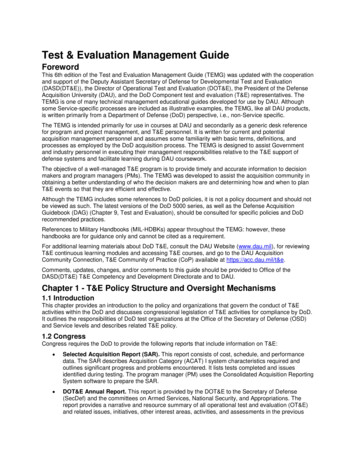
Transcription
Test & Evaluation Management GuideForewordThis 6th edition of the Test and Evaluation Management Guide (TEMG) was updated with the cooperationand support of the Deputy Assistant Secretary of Defense for Developmental Test and Evaluation(DASD(DT&E)), the Director of Operational Test and Evaluation (DOT&E), the President of the DefenseAcquisition University (DAU), and the DoD Component test and evaluation (T&E) representatives. TheTEMG is one of many technical management educational guides developed for use by DAU. Althoughsome Service-specific processes are included as illustrative examples, the TEMG, like all DAU products,is written primarily from a Department of Defense (DoD) perspective, i.e., non-Service specific.The TEMG is intended primarily for use in courses at DAU and secondarily as a generic desk referencefor program and project management, and T&E personnel. It is written for current and potentialacquisition management personnel and assumes some familiarity with basic terms, definitions, andprocesses as employed by the DoD acquisition process. The TEMG is designed to assist Governmentand industry personnel in executing their management responsibilities relative to the T&E support ofdefense systems and facilitate learning during DAU coursework.The objective of a well-managed T&E program is to provide timely and accurate information to decisionmakers and program managers (PMs). The TEMG was developed to assist the acquisition community inobtaining a better understanding of who the decision makers are and determining how and when to planT&E events so that they are efficient and effective.Although the TEMG includes some references to DoD policies, it is not a policy document and should notbe viewed as such. The latest versions of the DoD 5000 series, as well as the Defense AcquisitionGuidebook (DAG) (Chapter 9, Test and Evaluation), should be consulted for specific policies and DoDrecommended practices.References to Military Handbooks (MIL-HDBKs) appear throughout the TEMG: however, thesehandbooks are for guidance only and cannot be cited as a requirement.For additional learning materials about DoD T&E, consult the DAU Website (www.dau.mil), for reviewingT&E continuous learning modules and accessing T&E courses, and go to the DAU AcquisitionCommunity Connection, T&E Community of Practice (CoP) available at https://acc.dau.mil/t&e.Comments, updates, changes, and/or comments to this guide should be provided to Office of theDASD(DT&E) T&E Competency and Development Directorate and to DAU.Chapter 1 - T&E Policy Structure and Oversight Mechanisms1.1 IntroductionThis chapter provides an introduction to the policy and organizations that govern the conduct of T&Eactivities within the DoD and discusses congressional legislation of T&E activities for compliance by DoD.It outlines the responsibilities of DoD test organizations at the Office of the Secretary of Defense (OSD)and Service levels and describes related T&E policy.1.2 CongressCongress requires the DoD to provide the following reports that include information on T&E: Selected Acquisition Report (SAR). This report consists of cost, schedule, and performancedata. The SAR describes Acquisition Category (ACAT) I system characteristics required andoutlines significant progress and problems encountered. It lists tests completed and issuesidentified during testing. The program manager (PM) uses the Consolidated Acquisition ReportingSystem software to prepare the SAR. DOT&E Annual Report. This report is provided by the DOT&E to the Secretary of Defense(SecDef) and the committees on Armed Services, National Security, and Appropriations. Thereport provides a narrative and resource summary of all operational test and evaluation (OT&E)and related issues, initiatives, other interest areas, activities, and assessments in the previous
fiscal year. When oversight of live-fire testing (LFT) was moved to DOT&E, this issue was addedto the report. Beyond Low-Rate Initial Production (BLRIP) Report. Before proceeding to BLRIP for eachmajor defense acquisition program (MDAP), the DOT&E must report to the SecDef, DeputySecretary of Defense, Under Secretary of Defense for Acquisition, Technology and Logistics(USD(AT&L)), Secretaries of the Military Departments, and Congress. This report addresses theadequacy of the Service initial operational test & evaluation (IOT&E) and whether the T&E resultsconfirm that the tested item or component is effective, suitable, and survivable for combat. Whenoversight of live-fire test & evaluation (LFT&E) was moved to the DOT&E, the LFT Report wasadded to the BLRIP report content. Foreign Comparative Testing (FCT) Report. The USD(AT&L) should notify Congress aminimum of 30 days prior to the commitment of funds for initiation of new FCT evaluations ofequipment produced by select allied and friendly foreign countries. Joint DASD(DT&E) and Deputy Assistant Secretary of Defense for Systems Engineering(DASD(SE)) Annual Report. This report is required by statute to be provided to the committeeson Armed Services and Appropriations. The joint report includes the significant DevelopmentalTest and Evaluation (DT&E) and systems engineering (SE) activities for the Department'sMDAPs, major automated information systems (MAIS), and special interest programs. The reportevaluates the progress of weapon systems' performance for programs designated for OSD T&Eoversight.1.3 OSD Oversight StructureThe DoD organization for the oversight of T&E is illustrated in Figure 1-1. For the USD(AT&L), DT&Eoversight is performed by the DASD(DT&E), within the Office of the Assistant Secretary of Defense forResearch and Engineering (ASD(R&E)). The DOT&E provides OT&E oversight for the SecDef. Themanagement of MDAPs in OSD is performed by the Defense Acquisition Executive (DAE), who uses theDefense Acquisition Board (DAB) and Overarching Integrated Product Teams (OIPTs) to processinformation for decisions.
Figure 1-1 DoD Test and Evaluation Organizations1.3.1 DAEThe DAE position, established in September 1986, is held by the USD(AT&L). As the DAE, theUSD(AT&L) uses the DAB and its OIPTs to provide the senior-level decision process for the acquisition ofweapon systems. DAE responsibilities include establishing policies for acquisition (including procurement,research and development (R&D), logistics, developmental testing (DT), and contracts administration) forall elements of DoD. The DAE's charter includes the authority over the Services and Defense Agencieson policy, procedure, and execution of the weapon systems acquisition process.1.3.2 DABThe DAB is the senior advisory board for the DoD acquisition system. The board includes the Vice Chairof the Joint Chiefs, the service Secretaries, and a number of Undersecretaries of Defense. Members ofthe DAB are responsible for approving the MDAPs and serve as the most important executive review ofthe most expensive acquisition projects in the DoD. The DAB is also the principal review forum enablingthe USD(AT&L) to fulfill 10 USC Chapter 144 responsibilities concerning ACAT ID MDAPs.The USD (AT&L) is the Milestone Decision Authority (MDA) for ACAT ID programs and ACAT IAMprograms that have not been delegated. The USD(AT&L) conducts DAB Reviews for ACAT ID and IAMprograms at major milestone decision points, at the Full-Rate Production Decision Review, at InterimProgram Reviews, and at other times as necessary.1.3.3 DASD(DT&E)In accordance with DoD Instruction (DoDI) 5134.17 (Reference (a)), the DASD(DT&E) shall be the focalpoint for all policy, practice, procedures, and acquisition workforce issues relating to DT&E within DoD.
The DASD(DT&E) is the principal advisor to the SecDef and the USD(AT&L) on DT&E in the DoD inaccordance with section 139b of Title 10, United States Code (U.S.C.) (Reference (b)). See Figure 1-1.1.3.3.1 Responsibilities of the DASD(DT&E)Some of the key duties of the DASD(DT&E) include: Develops policies and guidance for the following:oThe planning, execution, and reporting of DT&E in the DoD, including integration andDT&E of software;oThe integration of developmental and operational tests in coordination with the DOT&E;oThe planning, execution, and reporting of DT&E executed jointly by more than oneMilitary Department or Defense Agency;oThe use of DT&E planning principles and best practices; andoThe development of test and evaluation strategies (TESs) and test and evaluation masterplans (TEMPs) in conjunction with the DOT&E. Provides guidance to defense acquisition programs for developing and documenting theprogram's evaluation strategy and management approach in the TES and TEMP throughout theprogram's life cycle. Reviews and approve DT&E portions in the TES and TEMP for each program on the OSD T&Eoversight list. Monitor and review, beginning with the materiel development decision, the DT&E anddevelopment planning activities of the pre-MDAPs and pre-MAIS programs. Monitor and review the DT&E activities of all MDAPs and MAIS programs and special interestprograms identified on the OSD T&E oversight list. In accordance with (IAW) DTM 09-027 (Reference (ac)), ensure access to all test data andprogram information relevant to the execution of testing and fulfillment of DASD(DT&E)responsibilities. Serves as the DoD functional leader for the T&E acquisition career field. Provide advocacy,oversight, and guidance to the acquisition workforce responsible for T&E. As an advisory member of the DAB and other key acquisition bodies, provides independentassessments, planned and ad hoc, of programs' DT&E, execution, and risk. Periodically review the organizations and capabilities of the Military Departments with respect toDT&E. Identify needed changes or improvements to such organizations and capabilities, andprovide input regarding needed changes or improvements for the T&E strategic plan. Submit to the congressional defense committees an annual report, jointly with the DASD(SE). Conduct an independent assessment of operational test readiness (AOTR) for all MDAPs andspecial interest programs. Jointly with the DOT&E, and in consultation with the T&E executives of the cognizant DoDComponents, determine the programs designated for OSD T&E oversight. Serve concurrently as the Director, Test Resource Management Center (TRMC), and in thiscapacity, report directly to the USD(AT&L) (as illustrated in Figure 1-1) in accordance with section196(f) of reference (b).1.3.3.2 DASD (DT&E) and Service ReportsDuring the testing of ACAT I and designated weapon systems, the DASD(DT&E) and Services interactionincludes the following reporting requirements: A TES must be provided for Milestone (MS) A and a TEMP (either preliminary or updated, as
appropriate) must be provided for consideration and approval before each milestone review,starting with MS B. A technical assessment of DT&E is provided to the ASD(R&E) and DOT&E listing the T&Eresults, conclusions, and recommendations prior to a milestone decision or the final decision toproceed to BLRIP.1.3.4 DOT&EThe DOT&E reports to the SecDef (as illustrated in Figure 1-1) and has special reporting requirements toCongress. The DOT&E must provide to Congress independent analysis and insight into the operationaleffectiveness, suitability, and survivability of new weapon systems.1.3.4.1 Duties and Authority of the DOT&ESome of the key duties and authority of the DOT&E as outlined in DoD Directive (DoDD) 5141.2(Reference (c)); DODI 5000.02 (Reference (d)); and sections 139, 2366, 2399, and 2400 of Reference (b)are as follows: Comply with requests from Congress for information relating to operational OT&E in the DoD. In conjunction with the DASD(DT&E), co-approve the TEMP and TES for major and otherdesignated defense acquisition programs, special interest programs, and other designatedautomated information system (AIS) programs. Approve operational test plans, and OT&E portions of test planning documents for major andother designated defense acquisition programs, special interest programs, and major and otherdesignated AIS programs. Approve the TEMP and T&E portions of integrated program management documents forprograms that are solely under DOT&E oversight. Approve test plans for operational test eventsof acquisition systems under DOT&E oversight. Approve LFT&E strategies and management plans and, if developed in support of waivers of fullup system-level LFT, alternative LFT&E strategies. Following consultation with the PM, determine the number of production or productionrepresentative test articles required for LFT&E and IOT&E of programs on the OSD T&Eoversight list. Obtain reports and information, as necessary in carrying out assigned responsibilities andfunctions. Provide independent oversight, independent evaluation, and objective reporting of the results ofoperational test and LFT&E. Determine adequacy of operational test capabilities. Monitor all OT&E activities. Coordinate Military Services planning and execution of OT&E. Review and make recommendations to the SecDef on all budgetary and financial matters. Provide early involvement in the acquisition cycle (integrated product team (IPT), informalreviews, etc.). Submit special reports to the SecDef and Congress.1.3.4.2 DOT&E and Service InteractionsFor DoD and DOT&E-designated oversight acquisition programs, the Service provides the DOT&E thefollowing: A draft copy of the operational test plan for review and approval. Significant test plan changes.
The final Service IOT&E report, which must be submitted to DOT&E before the Full-RateProduction Decision Review (FRPDR) for incorporation in the BLRIP report. The LFT&E plan for approval, and the Service LFT report for review.1.3.5 Defense Information Systems Agency (DISA)The DISA is responsible for planning, engineering, acquiring, testing, fielding, and supporting global netcentric information and communications solutions to serve the needs of the President, the Vice President,the SecDef, and the DoD Components, under all conditions of peace and war. The DISA supportsnational security communications requirements as identified in the National Security Presidential Directive– 28 (Reference (e)) and Executive Order 12472 (as amended) (Reference (f)).In accordance with DoDD 5105.19 (Reference (g)), the DISA maintains a major field independentoperational test capability (See Figure 1-1) through the Joint Interoperability Test Command (JITC).Under the direction of the Director, DISA, the JITC conducts operational test and evaluation, consistentwith DoD Directive 5000.1 (Reference (h)) and Reference (d).1.4 Service T&E Management Structures1.4.1 Army T&E Organizational RelationshipArmy Regulation (AR) 73-1 (Reference (i)) prescribes implementing policies and assigns responsibilitiesfor T&E activities during the systems acquisition processes. It applies to all systems (materiel andcommand, control, communications, and computers (C4), intelligence (I), and information technology (IT)(C4I/IT) developed, evolved, acquired, and managed under theauspices of AR 70–1 and the DAG (Reference (j)). Reference (i) applies to Army participation in joint testand evaluation (JT&E) and multi-Service operational test and evaluation (MOT&E). The Armymanagement structure for T&E is depicted in Figure 1-2.
Figure 1-2 Army T&E Organization1.4.1.1 Army Acquisition Executive (AAE)The Assistant Secretary of the Army for Acquisition, Logistics, and Technology (ASA(ALT)) has theprincipal responsibility for all Department of the Army matters and policy related to acquisition, logistics,technology, procurement, the industrial base, and security cooperation. Additionally, the ASA(ALT) servesas the AAE. The AAE administers acquisition programs by developing/promulgating acquisition policiesand procedures as well as appointing, supervising, and evaluating assigned program executive officers(PEOs) and direct-reporting PMs.1.4.1.2 Army T&E ExecutiveThe Army T&E Executive establishes, reviews, enforces, and supervises Army T&E policy andprocedures including overseeing all Army T&E associated with the system research, development, andacquisition of all materiel systems and C4/IT systems. As delegated by the AAE, the Army T&E Executiveis the sole Headquarters, Department of the Army (HQDA) approval authority for TEMPs.The Test and Evaluation Office within the Office of the Deputy Under Secretary of the Army, known as theDeputy Under Secretary of the Army for Test and Evaluation (DUSA-TE), provides support for the ArmyT&E Executive. In this capacity, it has the mission to establish policy and resources that are disciplinedand flexible enough to support safe and reliable equipment for the current and future Army and DoDchemical and biological defense. DUSA-TE also provides T&E subject matter expertise and oversight ofArmy and DoD chemical and biological acquisition programs and represents Army T&E interests at OSDand tri-Service committees and forums.1.4.1.3 Army Test and Evaluation Command (ATEC)ATEC supports the systems acquisition, force development, and experimentation processes throughoverall management of the Army’s T&E programs. In this role, ATEC manages the Army’s developmentaland operational testing, all system assessments and evaluations, and management of joint T&E. ATEC isthe Army’s independent operational test agency (OTA) reporting directly to the Vice Chief of Staff of theArmy (VCSA) through the Director of the Army Staff (DAS).ATEC has the primary responsibility for conducting (DTs) for the Army. Responsibilities include thefollowing: Perform the duties of Government developmental tester for all Army systems except forthose systems assigned to the Communications-Electronics Research, Development,and Engineering Center of the Army Materiel Command (AMC) Research, Developmentand Engineering Command (RDECOM) by HQDA (Deputy Chief of Staff, G-6); MedicalCommand (MEDCOM); Intelligence and Security Command (INSCOM); Space andMissile Defense Command (SMDC); and Army Corps of Engineers (ACE). Provide test facilities and testing expertise in support of the acquisition of Army and otherdefense systems. Operate and maintain the Army's portion of the Major Range and Test Facility Base(MRTFB) (except for the United States Army Kwajalein Atoll in accordance with DoDD3200.11, (Reference (k)). Provide testers with a safety release for systems before the start of pretest training fortests that use Soldiers as test participants. Provide safety confirmations for milestone acquisition decision reviews and the materielrelease decision. Manage the Army Test Incident Reporting System.1.4.1.3.1 Army Operational TestersThe U.S. Army Operational Test Command (OTC) within ATEC has the primary responsibility forconducting most Operational Tests (OTs) for the Army and supporting Army participation in Joint T&E.OTC responsibilities include the following:
Perform the duties of operational tester for all Army systems except for those systemsassigned to MEDCOM, INSCOM, SMDC, and United States Army Special OperationsCommand (USASOC). Perform the duties of operational tester for assigned multi-Service OTs and (on acustomer service basis) for Training and Doctrine Command (TRADOC) forcedevelopment tests and/or experimentation (FDT/E). Provide test facilities and testing expertise in support of the acquisition of Army and otherdefense systems, and for other customers on a cost-reimbursable and as-available basis. Program and budget the funds to support OT except out-of-cycle tests (which are usuallypaid for by the proponent). Develop and submit OT and FDT/E test resource plans (TRPs) to the Army's TestSchedule and Review Committee (TSARC).1.4.1.3.2 Army Evaluation Center (AEC)The AEC is an independent subordinate element within ATEC that has the primary responsibility forconducting Army system evaluations and system assessments in support of the systems acquisitionprocess. Decision makers use AEC’s independent report addressing an Army system’s operationaleffectiveness, suitability, and survivability. AEC responsibilities include the following: Perform the duties of system evaluator for all Army systems except for those systemsassigned to MEDCOM, INSCOM, and the commercial items (CI) assigned to ACE;conduct continuous evaluation (CE) on all assigned systems. Develop and promulgate evaluation capabilities and methodologies. Coordinate system evaluation resources through the TSARC. Preview programmed system evaluation requirements for possible use of modeling andsimulation (M&S) to enhance evaluation and reduce costs. Perform manpower and personnel integration assessments in coordination with DeputyChief of Staff, G-1 Army Research Laboratory (ARL)-Human Research and EngineeringDirectorate. Perform the integrated logistics support (ILS) program surveillance for Army systems.Perform independent logistics supportability assessments and report them to the Armylogistician and other interested members of the acquisition community.
1.4.2 Navy T&E Organizational RelationshipFigure 1-3 Navy Test and Evaluation OrganizationThe organizational structure for T&E in the Navy is illustrated in Figure 1-3. Within the Navy Secretariat,the Secretary of the Navy (SECNAV) has assigned general and specific research, development, test, andevaluation (RDT&E) responsibilities to the Assistant Secretary of the Navy for Research, Development,and Acquisition (ASN(RD&A)) and to the Chief of Naval Operations (CNO). The CNO has responsibilityfor the TEMP process. T&E policy and guidance are exercised through the Director, Innovation, Test andEvaluation, and Technology Requirements (CNO (N84)).1.4.2.1 Navy DT&E OrganizationsThe Navy’s senior systems development authority is divided among the commanders of the systemcommands with Naval Air Systems Command (NAVAIR) developing and performing DT&E on aircraft andtheir essential weapon systems; Naval Sea Systems Command (NAVSEA) developing and performingDT&E on ships, submarines, and their associated weapon systems; and Space and Naval WarfareSystems Command (SPAWAR) developing and performing DT&E on all other systems. Systemacquisition is controlled by a chartered PM or by the commander of a systems command. In both cases,the designated developing agency is responsible for DT&E and for the coordination of all T&E planning inthe TEMP. Developing agencies are responsible for the following: Develop test issues based on the thresholds established by user requirements. Identify the testing facilities and resources required to conduct the DT&E. Develop the DT&E test reports.
Reporting directly to the CNO, the President of the Board of Inspection and Survey is responsible forconducting acceptance trials of new ships and aircraft acquisitions and is the primary Navy authority forProduction Acceptance Test and Evaluation (PAT&E) of these systems.1.4.2.2 Navy Operational Test and Evaluation Force (OPTEVFOR)The Commander, Operational Test and Evaluation Force (COMOPTEVFOR) commands the Navy'sindependent OT&E activity and reports directly to the CNO. The functions of the OPTEVFOR include thefollowing: Establish early liaison with the developing agency to ensure an understanding of therequirements and plans. Review acquisition program documentation to ensure that documents are adequate tosupport a meaningful T&E program. Plan and conduct realistic OT&E. Develop tactics and procedures for the employment of systems that undergo OT&E (asdirected by the CNO). Provide recommendations to the CNO for the development of new capabilities or theupgrade of ranges. Conduct OT&E on Marine Corps aviation systems.1.4.3 Marine Corps T&E Organizational RelationshipThe Office of Program, Budget, and Execution, Headquarters Marine Corps, directs the total MarineCorps program effort to support the acquisition of new systems. The Marine Corps does not have aposition that is analogous to that of the Director, Innovation, T&E and Technology Requirements (CNO(N84)). The Commanding General (CG), Marine Corps Systems Command (MCSC) is the sponsor forRDT&E and is responsible for DT&E within the Marine Corps. The CG MCSC also reports directly to theASN(RD&A). Figure 1-3 illustrates the Marine Corps organization for T&E management.1.4.3.1 Marine Corps DT&E OrganizationsThe CG MCSC is the Marine Corps materiel developing agent and directly interfaces with the NavySystems Commands. The CG MCSC implements policies, procedures, and requirements for DT&E of allsystems acquired by the Marine Corps. The Marine Corps also uses DT&E and OT&E performed by otherServices, which may develop systems of interest to the Corps.1.4.3.2 Marine Corps Test and Evaluation Activity (MCOTEA)MCOTEA is responsible for the independent OT&E of assigned Navy, Marine Corps, and joint acquisitionprograms to ensure that all events are effectively planned, conducted, and reported. MCOTEAcoordinates the scheduling of resources for OT requiring Marine operating forces support through theMarine forces synchronization conferences. Aviation programs sponsored by the CNO undergoindependent OT&E by the COMOPTEVFOR.1.4.4 Air Force T&E Organizational RelationshipsAir Force Policy Directive (AFPD) 99-1 (Reference (l)) and the Air Force 99-serices of Instructionsestablishes policies for the T&E process and infrastructure.The Assistant Secretary of the Air Force for Acquisition (SAF/AQ) is the senior-level authority forresearch, development, and acquisition (RDA) within the Air Force. As illustrated in Figure 1-4, theSAF/AQ is an advisor to the Secretary of the Air Force and interfaces directly with the DASD(DT&E) andthe DOT&E. The SAF/AQ receives DT&E and OT&E results as a part of the acquisition decision process.Within the SAF/AQ structure, there is a military deputy (acquisition) who is the Air Force primary staffofficer with responsibility for RDA. The Director, Air Force Test and Evaluation (AF/TE), provides T&Epolicy and oversight and reports directly to the Chief of Staff of the Air Force (CSAF). AF/TE processesDT&E and OT&E documentation, resolves T&E issues for the Air Force, and manages the review of theTEMP.
1.4.4.1 Air Force DT&E OrganizationThe Air Force Materiel Command (AFMC) and Air Force Space Command (AFSPC) are implementingcommands that conduct Government DT&E and manage acquisition programs. AFMC and AFSPCperform all levels of research; develop weapons systems, support systems, and support equipment.Within these implementing commands are product centers, logistics centers, test centers, andlaboratories as well as a wide variety of test ranges.Once the weapon system is fielded, AFMC and AFSPC retain management responsibility for developingand testing system improvements and upgrades. The AFSC is responsible for DT&E of space andmissile systems.Figure 1-4 Air Force Test and Evaluation Organization1.4.4.2. Air Force Operational Test and Evaluation Center (AFOTEC)As the Air Force OTA, AFOTEC conducts independent OT&E of all programs on the OSD OT&EOversight List and other programs as directed. AFOTEC also conducts OTs in support of joint urgentoperational needs and Warfighter rapid acquisition programs. The AFOTEC commander reports directlyto the CSAF. In preparation for OT&E, AFOTEC reviews all relevant operational and trainingrequirements, employment and maintenance concepts, and tactics. Operational and implementing majorcommands (MAJCOMs) provide operational concepts, personnel, and resources to assist AFOTEC inperforming OT&E.1.4.4.3 MAJCOM Operational Test OrganizationsOT organizations (squadrons and wings) are embedded in each operating MAJCOM to conduct follow-onoperational test and evaluation (FOT&E) for systems past AFOTEC-conducted IOT&E and to conduct
OT&E on all systems in sustainment. Force development evaluations (FDEs), which are a type of OT&E,are performed by MAJCOM OT organizations in support of MAJCOM-managed system acquisitionrelated decisions prior to initial fielding or for MAJCOM sustainment or upgrade activities.1.5 SummaryAn increased emphasis on T&E has placed greater demands on the OSD and DoD Components tocarefully structure organizations and resources to ensure maximum effectiveness. Renewed interest byCongress in testing as a way of assessing systems utility and effectiveness, reports by a variety oforganizations on improving acquisition effectiveness, and continuing acquisition reform initiatives haveresulted in reorganizations within the DoD and the Services to improve the management of T&Eresources, planning, execution, and reporting, in support of acquisition programs.Chapter 2 - The T&E Process2.1 IntroductionThe fundamental purpose of T&E is to provide essential information to decision makers, verify andvalidate performance capabilities documented as requirements, assess attainment of technicalperformance parameters, and determine whether systems are operationally effective, suitable, survivable,and safe for intended use. During the early phases of development, T&E is conducted to demonstrate thefeasibility of conceptual approaches, evaluate design risk, identify design alternatives, compare andanalyze trade-offs, and estimate satisfaction of operational requirements. As a system undergoes designand development, the iterative process of testing moves gradually from a concentration on DT&E, whichis concerned chiefly with attainment of engineering design goals and verification of technicalspecifications, to increasingly comprehensive OT&E, which focuses on questions of operationaleffectiveness, suitability, and survivability. Although there are usually separate DT and OT events, DT&Eand OT&E are not necessarily serial phases in the evolution of a weapon system development. IntegratedDT and OT are encouraged when appropriate; i.e., conferring possible cost or time savings.The discipline of T&E has its origins in the testing of hardware. This tradition is heavily embedded in itsvocabulary and procedures. The advent of software-intensive systems has br
adequacy of the Service initial operational test & evaluation (IOT&E) and whether the T&E results confirm that the tested item or component is effective, suitable, and survivable for combat. When oversight of live-fire test & evaluation (LFT&E) was moved to the DOT&

